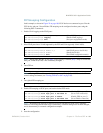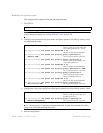
BLADEOS 6.5.2 Application Guide
204 Chapter 14: FCoE and CEE BMD00220, October 2010
Enhanced Transmission Selection
Enhanced Transmission Selection (ETS) is defined in IEEE 802.1Qaz. ETS provides a method for
allocating port bandwidth based on 802.1p priority values in the VLAN tag. Using ETS, different
amounts of link bandwidth can specified for different traffic types (such as for LAN, SAN, and
management).
ETS is an essential component in a CEE environment that carries different types of traffic, each of
which is sensitive to different handling criteria, such as Storage Area Networks (SANs) that are
sensitive to packet loss, and LAN applications that may be latency-sensitive. In a single converged
link, such as when implementing FCoE, ETS allows SAN and LAN traffic to coexist without
imposing contrary handling requirements upon each other.
The ETS feature requires CEE to be turned on (see “Turning CEE On or Off” on page 192).
802.1p Priority Values
Under the 802.1p standard, there are eight available priority values, with values numbered 0
through 7, which can be placed in the priority field of the 802.1Q VLAN tag:
Servers and other network devices may be configured to assign different priority values to packets
belonging to different traffic types (such as SAN and LAN).
ETS uses the assigned 802.1p priority values to identify different traffic types. The various priority
values are assigned to priority groups (PGID), and each priority group is assigned a portion of
available link bandwidth.
Priorities values within in any specific ETS priority group are expected to have similar traffic
handling requirements with respect to latency and loss.
16 bits 3 bits 1 12 bits
Tag Protocol ID (0x8100) Priority CFI VLAN ID
0151632


















